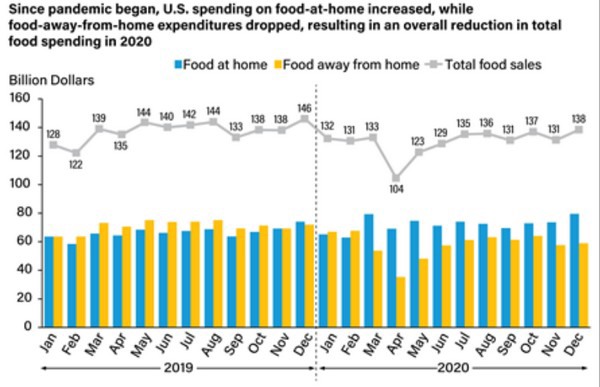For the past 25 years, U.S. food expenditures generally followed several predictable trends. Most notably, annual total expenditures and the share of food-away-from-home (FAFH) showed steady increases, with the highest share of FAFH spending occurring during the summer months. The coronavirus COVID-19 pandemic limited mobility of U.S. consumers and led to an economic recession for most of 2020, disrupting historical trends in food spending.
In 2020, people in the United States spent approximately $1.56 trillion on food. This was a 5.3 percent reduction from the $1.65 trillion spent on food in the United States in 2019 and was only the second time annual total food expenditures decreased over the last 25 years.
The other time spending decreased was in 2009 during the Great Recession. The decrease in total food spending in 2020 was driven by an 18.3-percent drop in spending at restaurants, cafeterias, and other eating-out places. Because of the additional cost of eating away from home, that decrease outweighed an 8.5-percent increase in food-at-home (FAH) spending as consumers shifted to buying more food from retailers like grocery stores, supercenters, and convenience stores.
In April 2020, U.S. consumers spent about two-thirds of their food dollars at FAH retailers, the highest value on record. FAH and FAFH spending increased 7.9 percent and 36.2 percent, respectively, from April to May 2020. This increase may be due in part to the stimulus checks and increased unemployment benefits that were provided with the enactment of the Coronavirus Aid, Relief, and Economic Security (CARES) Act at the end of March 2020. However, FAFH spending in May 2020 was still lower than the previous year, while FAH spending was higher. The last quarter of 2020 saw monthly increases in FAH spending, an expected outcome of colder weather and holiday meal preparation, which resulted in record-high FAH spending in December. FAFH spending decreased in November by 10 percent and showed a slight increase in December but remained well below 2019 levels.
While COVID-19 vaccine distribution for select groups began in the United States in December 2020, the post-pandemic landscape of the food economy remains unclear. The USDA, Economic Research Service will continue to monitor the effects of the pandemic on food expenditures as more data become available and will examine possible long-lasting behavioral changes in the way people purchase food.
For more information: ers.usda.gov

